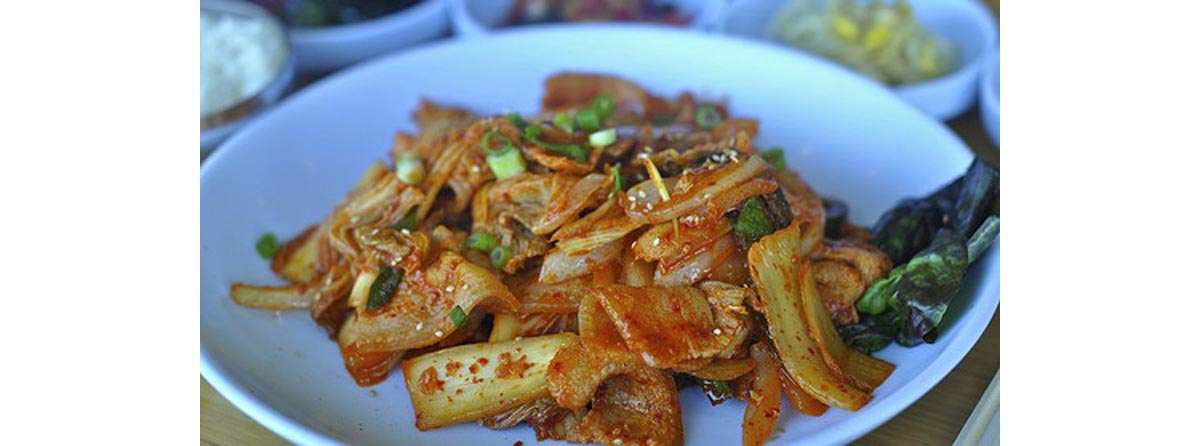Korean food is, without a doubt, very much an acquired taste. The hardest Korean dish to tackle, and actually start enjoying, is definitely kimchi. This national dish popular across the nation — North and South — comes in several different versions including radish kimchi and cucumber kimchi, but kimchi made with fermented Napa cabbage is most famous and usually what people refer to when they say only “kimchi”.

Kimchi: What's In There, And How To Get It
Kimchi's nutrients can help you lose weight, give you young-looking skin and even help prevent cancer. But those folks who have never tried kimchi and may never even have heard of this famous Korean dish will want to know about the basics before they think about buying or making this fermented cabbage treat.
Traditional Korean meals will always include some type of kimchi, either as a side dish (“banchan”) or served as part of a meal, like soup, pancakes, or rice cakes. For Koreans, traditional meals simply aren't complete without these kimchi dishes. Kimchi tends to be amazingly spicy.
The first time I tried the dish, my mouth just about burned and my eyes were teary. I was grateful there were other side dishes like plain rice and spinach with sesame seeds to extinguish the fire. I love kimchi now, and frequently make it myself, but there's no denying that it was not love at first sight!
You can get kimchi at any Korean restaurant or supermarket, and sometimes at Chinese markets too. Though tinned kimchi can be tasty, there is nothing quite as nice as home-made kimchi. Vegetarians, beware: commercially made kimchi almost always includes anchovies. The same holds true for most other Korean foods. You can't taste them, but they're there. That is why I make my own.
My vegetarian kimchi recipe contains the following essential ingredients
- Napa cabbage
- Scallions
- Garlic
- Ginger
- Salt
- Hot red pepper flakes
- Rice flower
Those adventurous cooks who want to make their own kimchi with anchovies will simply include them, and I have linked to a great recipe site that gives you video instructions in the links box at the end of the article.
The basics of how kimchi is made are still interesting to folks who plan to enjoy commercially-made kimchi. First, the Napa cabbage is washed and covered in salt. After a few hours, it will greatly reduce in size as the fluids are removed from the cabbage. Next, a paste of rice flower with all the other ingredients is added, and the dish is left to ferment for a few days, giving kimchi its characteristic sour taste.
The result is a pure taste of Korea, and a bunch of nutritional goodness concentrated into a small dish. You can eat kimchi by itself, of course, but it definitely shines when you can add it to other dishes. Kimchi pancakes are my personal favorite, though this spicey fermented cabbage is wonderful in soup as well.
Kimchi's Health Benefits
Kimchi has rightfully has a good reputation across the world now, as news of its wonders were spread through the globe with the help of the internet. This power food will help you look young and stay slim. It will help to keep your digestive system healthy and eating kimchi on a regular basis even helps to prevent certain cancers. Why is that? What makes this humble dish so special?

The Napa cabbage, scallions, chillies, garlic and ginger all contribute to making kimchi a power food. A few kimchi pancakes will easily satisfy your daily need for vitamin C, and there is also lots of carotene that the body converts to vitamin A. Then, you will find vitamins B1 and B2, iron and calcium. Kimchi is also a good source of selenium, which lowers your cholesterol levels and promotes healthy skin and hair.
Have you noticed that Koreans tend to look young well into middle-age, and even beyond? They will often say that their great skin (read: lack of wrinkles) is due to eating kimchi a lot. It only takes a look at neighboring countries to realize their Koreans don't have a monopoly on healthy- and young-looking skin, and genetics certainly play a role in how we age. Selenium really does work wonders as well, however. If you're reluctant to try Botox, give kimchi a go first.
Americans who have lived in South Korea to teach English come home with a great many stories. Culinary horror stories about live octopus dishes may be very memorable, but tales about how kimchi can help people lose weight are more valuable, because they can help everyone.
Some of the greatest benefits of kimchi come from the lactic acid, lactobacilli, and bifidobacteria inside the fermented dish. These healthy microorganisms do wonders for colon health, and can be of great help to anyone who is suffering from digestive problems. These perks come with other fermented products like yogurt and the German version of kimchi, sauerkraut, as well. Sauerkraut is quite similar to kimchi, but it does not offer the added nutrients of garlic, scallions and ginger — and is extremely bland and boring compared to kimchi.
The final and arguably most compelling reason to eat kimchi regularly is that it may well have cancer-fighting properties. Several Korean studies have looked into the possibility that kimchi could slow down tumor growth and help prevent lung cancer. These studies concluded that the high levels of vitamin A and C, which come from the chilly flakes found in kimchi, are responsible for slowing tumor growth. Capsaicin, the active component found in chilly peppers, helps prevent lung cancer. Meanwhile, the lactobacteria we mentioned earlier may fight colon cancer.
Korean cuisine has a lot to offer beyond the signature dish that kimchi represents. If we've sparked your interest in kimchi, please do look around for Korean recipes that usually accompany kimchi, many of which are also healthy. Your local Korean restaurant is a good place to start, but Korean food isn't too difficult to prepare yourself if you have a Korean grocery store nearby, either.
- Photo courtesy of James by Flickr : www.flickr.com/photos/40726522@N02/8929741934/
- Photo courtesy of moppet65535 by Flickr : www.flickr.com/photos/9880707@N02/5296111970/


Your thoughts on this